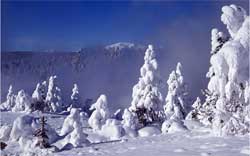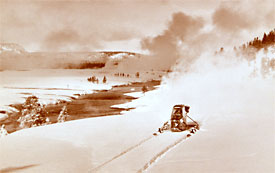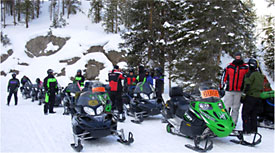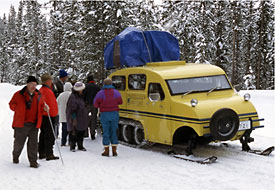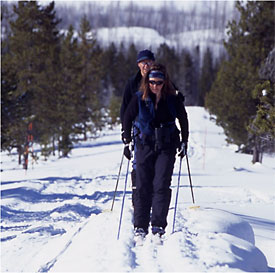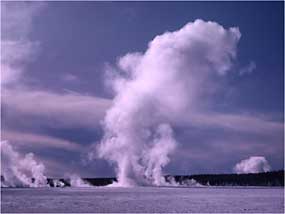July 26, 2010
Yellowstone Releases Draft Winter Use Alternatives
Work is progressing on a new winter use plan for Yellowstone National Park
 Comments received during public scoping in January, February and March have been reviewed and considered. They were used to help create a draft range of alternatives, which were released late last week.
Comments received during public scoping in January, February and March have been reviewed and considered. They were used to help create a draft range of alternatives, which were released late last week.
The six alternatives will be analyzed in the Draft Environmental Impact Statement (DEIS), which will be released for public review and comment in early 2011.
The alternatives cover a wide range of possible approaches to the future of winter use in the park. Two alternatives look at different daily limits on snowmobiles and snowcoaches. Another alternative focuses on daily and seasonal caps on machines, while allowing for some unguided snowmobile access to the park.
A proposal to phase out snowmobiles in favor of snowcoaches also is being considered; as is a plan to plow the roads from West Yellowstone and Mammoth Hot Springs so commercial wheeled vehicles could enter the park in the winter.
A "no-action" alternative would eliminate all snowmobile and snowcoach travel in the park after the 2010/2011 winter season.
A summary of the comments received during public scoping, and a newsletter that describes the range of alternatives are available on the National Park Service Planning, Environment, and Public Comment (PEPC) website at http://parkplanning.nps.gov/yell, and click on Winter Use Plan; or by calling (307) 344-2019. (See the attached PDF, which includes the newsletter referred to.)
Yellowstone plans to host two online, one-hour "webinars" on Aug. 3 and Aug. 5 to provide the public with more information on the range of alternatives and to explain the ongoing winter planning process. In addition, the park plans to hold a one-hour conference call the same week, on Aug. 4, for those who do not have computer access or who cannot participate in either of the webinars.
The webinars are scheduled for Tuesday, Aug. 3, 7-8 p.m. MDT; and Thursday, August 5, 10-11 a.m. MDT. To participate in the webinars for Yellowstone’s winter use plan, first read the newsletter (link above) about the draft range of alternatives. Then, go to https://www1.gotomeeting.com/register/936260544 to register for the Aug. 3 session; or https://www1.gotomeeting.com/register/302796888 to register for the Aug. 5 session. You can visit these links at any time to register up until each webinar starts.
At each of the gotomeeting.com links above, you will be asked to give your name and email address, so that the system can confirm your participation and email you a computer link you will use to connect to the webinar on the scheduled day and time. You can ask questions during the webinar by typing and submitting them from your computer keyboard. However, you also can send questions in advance IF you do so when you first register for the webinars.
You can type your advance questions about the range of alternatives into the box provided on the registration page. Again, please note: The only way to submit a question in advance is to do so when you register for the webinar. You can submit any other questions live after the webinars begin.
In addition, you will have the option to listen to the webinar in two ways: over your computer speakers while viewing the presentation or by telephone while viewing the webinar on your computer. Please be aware that the phone-in option that gotomeeting.com will provide at the time of the webinar will NOT be a toll-free call and may incur long-distance charges.
The conference call is slated for Wednesday, Aug. 4, 7-8 p.m. MDT. The toll free number for the call is 877-918-1346 (this number is for calls from U.S. telephones only). Please enter the passcode, 8654495 followed by the pound (#) sign.
The NPS will provide a 60-day public review and comment period on the alternatives and their analyses when the DEIS is released in early 2011.
www.nps.gov/yell
Yellowstone Releases Draft Winter Use Alternatives
Work is progressing on a new winter use plan for Yellowstone National Park

The six alternatives will be analyzed in the Draft Environmental Impact Statement (DEIS), which will be released for public review and comment in early 2011.
The alternatives cover a wide range of possible approaches to the future of winter use in the park. Two alternatives look at different daily limits on snowmobiles and snowcoaches. Another alternative focuses on daily and seasonal caps on machines, while allowing for some unguided snowmobile access to the park.
A proposal to phase out snowmobiles in favor of snowcoaches also is being considered; as is a plan to plow the roads from West Yellowstone and Mammoth Hot Springs so commercial wheeled vehicles could enter the park in the winter.
A "no-action" alternative would eliminate all snowmobile and snowcoach travel in the park after the 2010/2011 winter season.
A summary of the comments received during public scoping, and a newsletter that describes the range of alternatives are available on the National Park Service Planning, Environment, and Public Comment (PEPC) website at http://parkplanning.nps.gov/yell, and click on Winter Use Plan; or by calling (307) 344-2019. (See the attached PDF, which includes the newsletter referred to.)
Yellowstone plans to host two online, one-hour "webinars" on Aug. 3 and Aug. 5 to provide the public with more information on the range of alternatives and to explain the ongoing winter planning process. In addition, the park plans to hold a one-hour conference call the same week, on Aug. 4, for those who do not have computer access or who cannot participate in either of the webinars.
The webinars are scheduled for Tuesday, Aug. 3, 7-8 p.m. MDT; and Thursday, August 5, 10-11 a.m. MDT. To participate in the webinars for Yellowstone’s winter use plan, first read the newsletter (link above) about the draft range of alternatives. Then, go to https://www1.gotomeeting.com/register/936260544 to register for the Aug. 3 session; or https://www1.gotomeeting.com/register/302796888 to register for the Aug. 5 session. You can visit these links at any time to register up until each webinar starts.
At each of the gotomeeting.com links above, you will be asked to give your name and email address, so that the system can confirm your participation and email you a computer link you will use to connect to the webinar on the scheduled day and time. You can ask questions during the webinar by typing and submitting them from your computer keyboard. However, you also can send questions in advance IF you do so when you first register for the webinars.
You can type your advance questions about the range of alternatives into the box provided on the registration page. Again, please note: The only way to submit a question in advance is to do so when you register for the webinar. You can submit any other questions live after the webinars begin.
In addition, you will have the option to listen to the webinar in two ways: over your computer speakers while viewing the presentation or by telephone while viewing the webinar on your computer. Please be aware that the phone-in option that gotomeeting.com will provide at the time of the webinar will NOT be a toll-free call and may incur long-distance charges.
The conference call is slated for Wednesday, Aug. 4, 7-8 p.m. MDT. The toll free number for the call is 877-918-1346 (this number is for calls from U.S. telephones only). Please enter the passcode, 8654495 followed by the pound (#) sign.
The NPS will provide a 60-day public review and comment period on the alternatives and their analyses when the DEIS is released in early 2011.
www.nps.gov/yell
Last edited:



